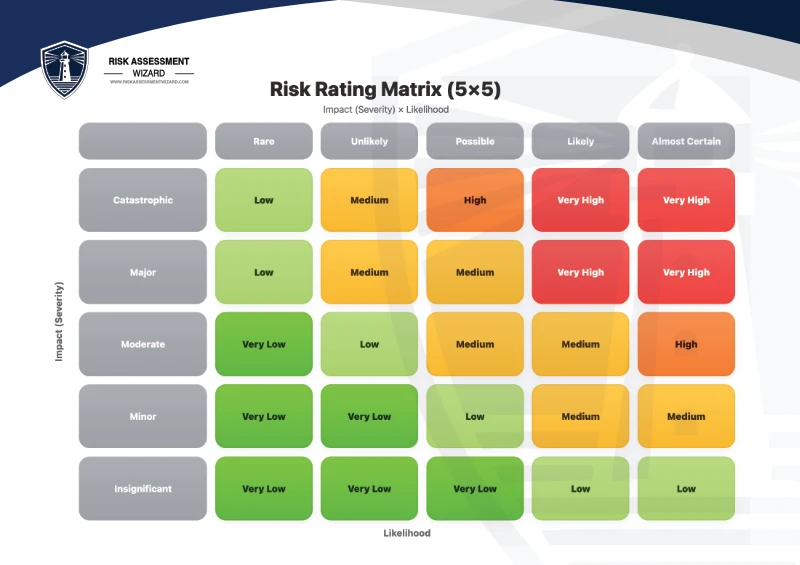Assessing the Risk
Assessing the risk is simply judging how likely harm is and how bad it would be, then deciding sensible controls. This page keeps it short and practical.
Quick index
1. What “assessing the risk” actually means
It’s a sensible look at what could cause harm, who might be harmed and how, how likely/serious it could be, and what you’ll do about it. The output is a short record and a set of practical controls that people will actually follow.
1.1 Hazard vs risk
- Hazard: something that can cause harm (e.g., hot liquids, moving vehicles, poor housekeeping).
- Risk: the chance that harm occurs and how bad it would be.
1.2 The record
Keep it clear and brief: list hazards, who’s at risk and how, your controls, owners/dates, and the risk rating before and after controls.
2. The 5 steps
- Identify hazards – anything that could cause harm.
- Assess the risks – who may be harmed and how; consider likelihood and impact before controls.
- Control the risks – choose proportionate measures and assign owners/dates.
- Record your findings – short, plain-English results that people will follow.
- Review and update – when things change or on a sensible schedule.
3. How to score risk (likelihood × impact)
Likelihood is how often it might happen; impact is how bad it would be. Multiply or cross‑reference them to get a risk level that drives action.
3.1 Choose a simple matrix
Use a 3×3 for quick decisions, or 5×5 when you need finer bands. Keep definitions short and observable (e.g., “once per year”, “first‑aid only”).

Action cues: Low – accept with routine controls; monitor. Medium – improve controls; assign owner/date. High – don’t proceed until further reduction is in place.
4. Choosing proportionate controls
- Training & briefing: short, focused, and recorded.
- Supervision & ratios: appropriate to the task and people involved.
- Equipment & checks: fit for purpose; inspection/maintenance noted.
- Environment & housekeeping: tidy routes, good lighting, spill response.
- Procedures & signage: clear steps; simple reminders where needed.
- PPE: sensibly chosen (last resort, not first option).
Assign an owner and date for new measures so things actually get done.
5. Worked example (table)
| Hazard | Who might be harmed & how | Existing controls | Further measures | Risk before | Risk after | Owner & date |
|---|---|---|---|---|---|---|
| Slips on wet foyer floor | Visitors & staff – bruises/fractures | Entrance mats; wet‑floor signs | Increase mat coverage; hourly spill checks; fix door drip | Medium | Low | J. Smith – 15 Oct |
| Hot liquids in kitchenette | Staff – burns | Kettle safety switch; posted guidance | Lidded flasks for transport; “no open cups in corridors” added to induction | Medium | Low | A. Patel – 30 Sep |
Score “before/after” using your chosen matrix. Keep your team on a single scale and set of definitions.
6. Common mistakes to avoid
- Writing an essay: long documents don’t get read. Keep it short and useful.
- Vague scoring: “rare” or “serious” without definitions leads to arguments. Define terms.
- No owners/dates: controls drift if no one owns them.
- Copy‑paste blindness: review when things change; don’t reuse stale risks.
7. FAQs
What’s the difference between a hazard and a risk?
A hazard is something that can cause harm. A risk is the chance that harm occurs and how severe it could be.
Do we need a 5×5 matrix?
Not always. A 3×3 covers many cases and is quicker. Use 5×5 when you need finer discrimination. Pick one and stick with it.
Can I export a tidy PDF with our logo?
Yes. Build your assessment in the wizard and export a branded PDF. You can try the tool without creating an account.
Is this legal advice?
No. This is general guidance. You’re responsible for completeness and accuracy and must follow local regulations and your organisation’s policies.

